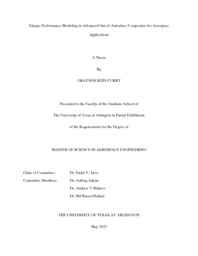
ATTENTION: The works hosted here are being migrated to a new repository that will consolidate resources, improve discoverability, and better show UTA's research impact on the global community. We will update authors as the migration progresses. Please see MavMatrix for more information.
Show simple item record
| dc.contributor.advisor | Iarve, Endel V | |
| dc.creator | Curry, Grayson Reid | |
| dc.date.accessioned | 2023-06-14T17:05:29Z | |
| dc.date.available | 2023-06-14T17:05:29Z | |
| dc.date.created | 2023-05 | |
| dc.date.issued | 2023-05-04 | |
| dc.date.submitted | May 2023 | |
| dc.identifier.uri | http://hdl.handle.net/10106/31226 | |
| dc.description.abstract | Increased application of composite materials in the military and civil applications renewed the interest to development of high-fidelity methodologies for predicting their performance characteristics. Besides the traditional autoclave processed structural composites such as IM7/8552 and IM7/977-3 widely used on various platforms, novel materials such IM7/5320-1 suitable for Out-of-Autoclave (OoA) cure became of interest. Static and fatigue performance prediction of Open-Hole quasi-isotropic laminates made from IM7/5320-1 was performed in this work by using the Finite Element Analysis software BSAM. Progressive failure simulation including delaminations, matrix cracks and fiber failure was performed. Regularized eXtended Finite Element Methods (RXFEM) was used for mesh independent on-the-fly insertion of intralaminar matrix cracks. The Cohesive Zone Model (CZM), and the strength tracking methods were used for both inter and intralaminar crack propagation during fatigue loading. In addition, to capture the accurate stress ratio in each material point of the structure an algorithm for recoding local R-ratio was implemented. A Continuum Damage Mechanics (CDM) model was used for fiber failure initiation and propagation. It is the only damage mode modeled by CDM. Previously developed and validated static failure method was extended to fatigue damage prediction by applying S-N based strength reduction and proportional empirical reduction of the effective fiber fracture toughness in compression. The RXFEM methodology, previously applied to tension-tension cases was expanded to perform analysis under compression-compression and compression-tension loading conditions. Three different loading amplitudes were determined based on static strength. Delamination, matrix cracks, and fiber failure damage accumulation found during the fatigue analysis was compared with the experimental results found in the Advanced Material Characterization and Structural Certification (AMCS) Volume 1 by the National Institute for Aviation Research (NIAR). All material properties required for analysis were provided by NIAR including static and fatigue properties. The results obtained under tension-tension loading showed the best correlation of extent and location of matrix cracks and delamination with the experimental data. Fiber damage was most notably found in the compression-compression model, predicting appropriate length in zero- and forty-five-degree plies. All three damage modes were observed in compression-tension in outer and zero-degree plies. The similarities and differences in computed results and experiment are discussed. | |
| dc.format.mimetype | application/pdf | |
| dc.language.iso | en_US | |
| dc.subject | composites | |
| dc.subject | fatigue | |
| dc.subject | RXFEM | |
| dc.subject | Cohesive Zone Model | |
| dc.subject | CZM | |
| dc.subject | Local R-Ratio | |
| dc.subject | Out-of-Autoclave | |
| dc.subject | Fiber failure | |
| dc.subject | matrix cracks | |
| dc.subject | delamination | |
| dc.title | Fatigue Performance Modeling in Advanced Out-of-Autoclave Composites for Aerospace Applications | |
| dc.type | Thesis | |
| dc.date.updated | 2023-06-14T17:05:29Z | |
| thesis.degree.department | Mechanical and Aerospace Engineering | |
| thesis.degree.grantor | The University of Texas at Arlington | |
| thesis.degree.level | Masters | |
| thesis.degree.name | Master of Science in Aerospace Engineering | |
| dc.type.material | text | |
| dc.creator.orcid | 0009-0005-4935-7566 | |
Files in this item
- Name:
- CURRY-THESIS-2023.pdf
- Size:
- 3.502Mb
- Format:
- PDF
This item appears in the following Collection(s)
Show simple item record


